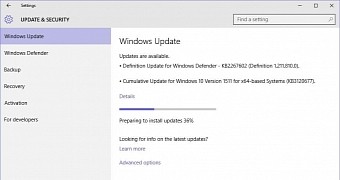Microsoft rolled out Windows 10 cumulative update KB3120677 yesterday in order to address some issues found in Threshold 2, but as we’ve already told you, some are experiencing issues when trying to install it and cannot complete the process.
But even if you do manage to install this update, you might notice some unexpected changes, as we’re receiving reports that, in some cases, it resets the default apps, and on rare occasions, privacy settings, switching them all to on. We can’t confirm the latter for now, but you should check your configuration after installing the update to see if any privacy changes have been made.
Unexpected behavior
First of all, the installation issues. Some of our readers have already confirmed these problems and said that neither automatic nor manual install worked.
Reader EpicFail, whose name pretty much says everything, explains:
“Still can't install update, either via WUS or the SDK both fail and both give the same error code as explained above. Frustrating to say the least. Lazy support just suggested to refresh os. But we all know what that does to pre purchased one time licensed software.”
On the other hand, our reader bDN claims his privacy settings were actually reset after installing this update.
“This update completely started all services that i have disabled, and turn on all privacy stuff on. Installed some phone stuff that no one needs, and all other apps bundled with windows,” he writes.
On Twitter, our friend @Buddahfan reveals that this cumulative update also reset his default apps, while other PCs experienced unusual behavior, including automatic disabling of the screen saver lock feature.
And last but not least, our reader HSone says the update changed absolutely nothing about the privacy settings that Microsoft promised to restore after the Threshold 2 blunder.
So if you install this cumulative update, make sure you check if it changes anything on your PC because, in some cases, it appears to be doing much more than Microsoft said in the first place.

 14 DAY TRIAL //
14 DAY TRIAL //